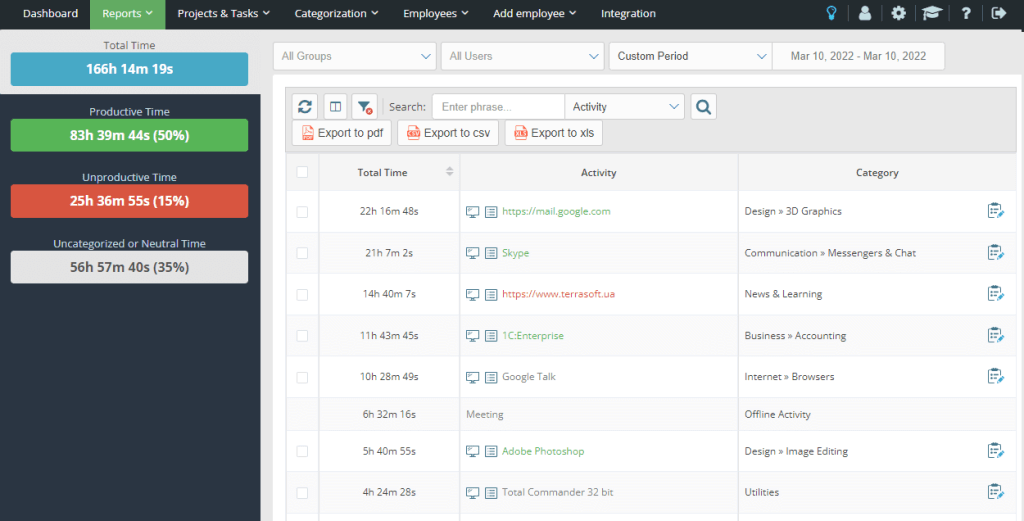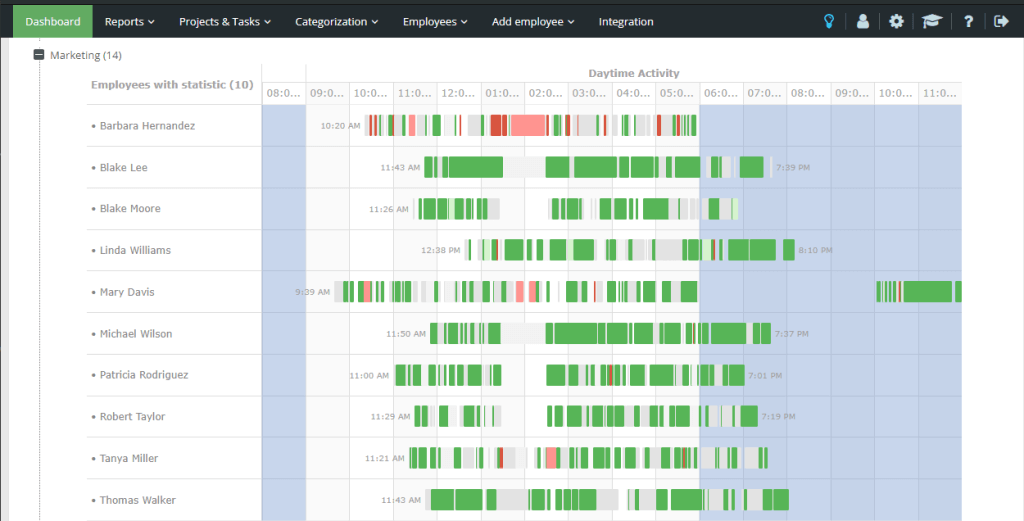When companies scale beyond 100 employees, management loses the intuitive grasp of how time and resources flow through the organization. Time tracking at this scale reveals systemic inefficiencies, hidden bottlenecks, and productivity patterns that are invisible to even experienced executives. The insights from enterprise-level tracking fundamentally change how leadership approaches planning, resource allocation, and operational optimization.
Why time tracking matters more in large companies
Scaling from 50 to 100+ employees creates a fundamental shift in organizational complexity. What once could be managed through direct observation and informal check-ins now requires systematic data collection to maintain operational visibility.
Chaotic scaling emerges when growth outpaces management systems. Teams multiply, processes fragment across departments, and coordination overhead grows exponentially. Without tracking, executives operate on assumptions about productivity that may be completely wrong.
Gut feeling stops working past the 70-employee threshold, where individual manager intuition can no longer capture the full organizational picture. McKinsey research on standout companies shows that productivity growth is concentrated among a small number of firms that systematically measure and optimize their operations, rather than relying on broad efficiency assumptions.
Hard attribution of delays or burnout becomes nearly impossible without data. When a project misses deadlines in a large organization, determining whether the issue was insufficient resources, unclear requirements, or genuine capability gaps requires forensic analysis that time tracking provides automatically.
Visibility creates control without micromanagement. Large-scale tracking focuses on patterns and trends rather than individual behavior, allowing leaders to address systemic issues while preserving team autonomy.
What problems time tracking reveals at scale
Large organizations develop systemic inefficiencies that compound over time, creating significant productivity drains that often go unnoticed until they reach crisis levels. These problems are particularly insidious because they appear normal to employees who have adapted to dysfunctional processes.
Systemic inefficiencies in large companies manifest as patterns rather than isolated incidents. A single inefficient meeting might waste an hour, but a culture of poorly planned meetings can consume 20-30% of organizational capacity. Time tracking reveals these patterns by aggregating behavior across hundreds of employees, making the invisible visible to decision makers.
Five hidden drains time tracking exposes:
- Silent overload of key roles – Senior specialists handling 60% more requests than documented in their job descriptions, creating bottlenecks that delay multiple projects simultaneously.
- Meeting proliferation – Teams spending 35-45% of their time in meetings, with most participants contributing minimally to outcomes while losing focus time for actual deliverables.
- Cross-departmental handoff delays – Tasks sitting idle for days between departments due to unclear ownership, approval processes, or communication gaps that nobody tracks manually.
- Under-utilized specialists – Expert resources working below capacity in some areas while other teams struggle with similar challenges, revealing opportunities for internal consulting models.
- Rework loops from unclear scope – Projects consuming 40-60% more time than estimated due to changing requirements, inadequate initial planning, or communication failures between stakeholders.
These systemic drains compound across large organizations, potentially consuming 20-30% of total organizational capacity without being visible to traditional management approaches.
How analytics shift from individual to team-level at 100+ employees
Enterprise time tracking fundamentally changes focus from individual performance monitoring to organizational pattern analysis. The goal shifts from watching what people do to understanding how work flows through complex systems.
Aggregated trends matter more than individual behavior because single-person productivity varies naturally while organizational patterns reveal structural issues. A developer having a slow week is normal; an entire engineering team showing declining velocity indicates systemic problems requiring management attention.
Managing patterns instead of people becomes essential at scale. Leaders need to identify when meeting frequency spikes indicate coordination problems, when rework percentages suggest process failures, or when overtime patterns signal resource shortages. Individual tracking becomes the foundation for systemic insights.
Dashboards for departments provide managers with actionable intelligence about their areas while protecting individual privacy. Department heads can see that their team spends too much time on administrative tasks without knowing which specific individuals are affected, enabling process improvements without creating surveillance concerns.
Heatmaps, spikes, and anomalies across weeks help identify seasonal patterns, project-driven workload variations, and emerging problems before they become critical. This temporal analysis is impossible without systematic tracking but provides crucial insights for capacity planning and resource allocation.
How managers use time tracking insights to plan better
Time tracking data transforms project management from guesswork to evidence-based planning. Managers gain historical baselines for similar work, realistic timelines for complex projects, and early warning systems for potential delays.

More accurate sprint forecasts become possible when teams have data showing how long similar tasks actually took in previous iterations. Instead of estimating based on optimistic assumptions, planning can use proven baselines adjusted for current conditions and team capacity.
Load balancing between overloaded and underused staff addresses one of the most common efficiency problems in large organizations. Tracking reveals when star performers are burning out while other team members have capacity, enabling proactive redistribution before problems escalate.
Predicting bottlenecks before they hit allows managers to address resource constraints proactively. When tracking shows that code review consistently takes longer than planned, managers can allocate additional senior developers or streamline the process before deadlines are missed.
Negotiating better deadlines with clients based on real data strengthens external relationships and improves delivery predictability. Instead of promising turnaround times based on hope, managers can provide estimates backed by historical performance data, reducing conflicts and managing expectations appropriately.
Case Study: How a 120-person IT firm cut overtime by 30%
A custom software development company struggled with chronic overwork, missed deadlines, and team burnout despite having talented developers and reasonable client expectations. Projects consistently ran 40-50% over estimate, forcing teams to work evenings and weekends to meet commitments.
Before implementing tracking, the company relied on Jira estimates and weekly status reports that showed tasks as complete or incomplete. This binary view provided no insight into why estimates were consistently wrong or which parts of the development process created delays.
During the three-month tracking implementation, they discovered that their planning assumptions were fundamentally flawed. Development tasks matched estimates reasonably well, but requirements clarification, stakeholder reviews, and deployment processes took far longer than anyone realized.
After six months of data collection and process adjustments, the company achieved significant operational improvements. They restructured project timelines to account for actual review cycles, created dedicated requirements-gathering phases, and automated deployment processes that previously required manual coordination.
Five specific outcomes they achieved from tracking reports:
- Eliminated 40% of recurring meetings – Data showed that many weekly status meetings provided no unique value and could be replaced with asynchronous updates, freeing 8 hours per week per team member.
- Restructured estimation templates – Historical data revealed that security reviews and client feedback cycles consistently took 3x longer than estimated, leading to more realistic project timelines.
- Created a requirements specialist role – Tracking showed that developers spent 25% of their time clarifying project requirements, justifying a dedicated role that improved both speed and accuracy.
- Automated testing and deployment – Time data proved that manual processes consumed 15% of development capacity, supporting investment in automation tools that reduced deployment time by 80%.
- Implemented workload monitoring – Real-time tracking allowed managers to identify overload situations before they became critical, reducing overtime from 20 hours per week average to 6 hours per week.
The transformation demonstrated how systematic measurement could reveal hidden inefficiencies and support evidence-based process improvements that benefited both employee wellbeing and business outcomes.
What to look for in a time tracker if your team is 100+
Enterprise-scale time tracking requires fundamentally different capabilities than tools designed for small teams. The focus shifts from detailed individual monitoring to sophisticated analytics, data security, and integration capabilities that support complex organizational structures.

Scalable dashboards must handle hundreds of users while providing relevant views for different organizational levels. Executives need high-level trends, department managers need team summaries, and project managers need task-level details, all from the same underlying data.
Role-based access control becomes critical when tracking data includes sensitive information about individual performance, salary-relevant productivity metrics, and strategic project details. Different stakeholders need different views without compromising privacy or security.
API and reporting integrations allow time tracking data to enhance existing business intelligence systems, project management tools, and HR platforms. Isolated tracking tools provide limited value compared to systems that integrate with organizational workflow and decision-making processes.
Aggregated plus drill-down flexibility enables investigation of interesting patterns without compromising individual privacy. Managers can identify that Project X is running behind schedule and drill down to understand whether the issue is resource allocation, technical complexity, or external dependencies.
Non-intrusive tracking UX ensures adoption across diverse user groups without disrupting productive work. Enterprise solutions must work across different devices, integrate with existing tools, and require minimal daily interaction while providing comprehensive data collection.

